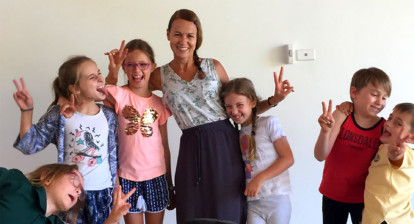If your child has recently shared with you that he or she is being bullied, you are certainly feeling upset and angry right now. But at least consider yourself fortunate to be in on the secret. Many children refuse to share that they are being bullied. This is why it is so important for teachers and parents to work together and constantly remain mindful of the signs of bullying.
Signs to look for that your child may be a victim of bullying are:
- mood swings
- aggressive behavior at home
- withdrawal (happy kids don’t normally withdraw)
- sleep problems
- no interest in school
- excuses for not going to school
- upset/depressed at the thought of returning to school after the weekend
- fear when talking about school
- doesn’t talk about any friends or school events
- nothing positive to say about school
- seems depressed or distant
- just seems sad
Bullying can be physical, emotional, verbal, cyber, rumors, threats, and/or damage to personal property. A bully’s energy can be strong, overpowering and intimidating. And that’s exactly what the bully wants your child to perceive.
Over 160,000 children miss school each year due to bullying. Bullying has drawn nationwide attention due to the devastating effects it can have on children, even costing lives in some cases. Bullying is a very serious social issue around the globe and must not be minimized.
Boys and girls both are susceptible to bullying. However, boys tend to report it less due to embarrassment. Bullying has reached epidemic proportions in America today. The number of bullying victims does seem to go down as children get older, as a study from Clemson University showed in 2010. However, older children who were bullied tend to have been tormented for years. Additionally, according to that same study, kids felt they were without protection from bullying. It’s really up to us as parents then to equip our children with what they need to combat bullying. So what tools can we give our kids? Following are the techniques to use and ideas to share with your children right away.
1. Control personal space and walk tall. Bullies choose their targets by picking on whom they perceive to be easy targets who won’t make much of a fuss. They often choose those who do not seem likely to fight back. If your child does not learn to stand up for himself, he may easily become the target of a bully. Walking nervously with the head down and shoulders bent attracts attention and screams out “I don’t feel good about me.” Practice assertive body language together by walking taller and with confidence at home. Help your child learn to claim personal space as his own and never let someone else come too close and make him feel smaller than he is.
2. Stand up for yourself. It’s hard to do sometimes, but necessary. Fifty percent of the time the bullying will stop if the victim just stands up for him or herself. Simply tell the bully to stop it!
3. Your child must build self confidence. In order to do this, he has to project himself with confidence, in his mind and in his environment. Start using positive affirmations and nightly positive visualizations so your child can begin to really see himself as strong, confident and capable. Nighttime audio relaxations will also help your child manage stress and anxiety better. Talk with your child to see where he feels he would like to improve himself. Sometimes children can say nasty things. If your child is very confident in who he is, he will not be as affected by other’s statements and opinions. Take the time to develop your child’s self esteem. This is critical. Bullies choose their targets from children with weakened self esteem. You may not even know why your child’s self esteem is weak, but right now the most important thing is to start building it up. You can start tonight.
4. Teach your child to make healthy eye contact with others. Making eye contact shows you are confident in who you are. Practice at home, while out shopping, at the post office – any time your child gets the opportunity to practice healthy eye contact. Healthy eye contact goes back to healthy self esteem. When a child feels good about himself, he will naturally stand taller, make eye contact, start friendly conversations with others and stand up for himself. You want to help your child be bulletproof to bullies.
5. Make sure the school and teachers are aware of the situation. Teachers and parents should work together as much as possible to control bullying situations. Many times teachers are not aware of what is happening, but even when they are, children often report that little or nothing is done to help. In the study done by Clemson University, 30% of boys in grades 3-5, and 60% of boys in grades 9-12 said their teacher had done little or nothing to stop the bullying. The truth is, many teachers are not equipped to deal with bullying issues and simply don’t know how to handle it. Appallingly, some teachers are even bullied themselves by students. However, a few teachers have been specially trained to deal with bullying issues, and there is always the hope that your child’s teacher will be well versed in how to deal with bullying. In any case, at the very least, talk the situation over with the teacher and the school counselor. Ask for recommendations. Do not listen to recommendations that include ignoring the bullying. It doesn’t work. Children end up internalizing the pain even more.
6. Enroll your child in martial arts. Often it takes just several weeks for your child to feel completely different about any bully situation. Today many martial art classes have integrated anti-bullying programs as well and are well aware of this problem in our society.
7. Take the little things your child mentions seriously, even if just he mentions it in passing. Any threat he has received should be immediately investigated and taken seriously.
8. If a bullying situation is not alleviated within a fairly short amount of time, decide to take your child out of school and home educate. As bullying escalates around the nation, parents must realize that there is a safe, viable option. It is home education. While it’s true that home education requires a bit of organization, it can give your child the time to recuperate and grow her self worth while focusing on true learning. It is legal in all states in the US and it completely eliminates peer pressure and test anxiety. It can also completely eliminate bullying. This is not to say that homeschool children never experiencing bullying, but they are simply not exposed to bullying and aggression as school children are. Bullying in the homeschooling environment is very rare. Encouragingly, homeschooled children in general have a very high self esteem and self worth which makes them less of a bully target as well. They feel competent. Homeschooling doesn’t imply that the children stay at home all day long either. Quite the contrary. Homeschool learning cooperatives are popping up like ice cream trucks at a summer playground. There, children get together on a weekly or bi-weekly basis to explore topics of interests. Often mothers teach subjects that they were skilled in before becoming Mommy. When faced with a bully, home educated children are often easily able to deflect aggression simply because they are not forced to stay in situations that are deemed a possible health risk. A parent does have control over the environment in this case and can monitor interactions and give immediate aid when needed. Homeschooling could be a temporary solution for a year or two, or it could become a permanent solution depending on the desires of the family. Recently, it has become more common to see middle and high school teens starting to home school because of unresolved school bully situations. Parents are simply not willing to take the risks that come with bullying anymore.
9. Realize that Bullying is often perpetuated by groups of children rather than one child alone. When this happens, victims can feel very helpless and isolated, as if everyone hates them and as if it really must be their fault if so many children are against them. Most parents are not aware of the magnitude of group bullying or the devastating effect it has on children and teens. Thanks to a handful of parents and educators coming forward in the media recently, awareness is growing.
10. Talk to your child continually and always allow the door of communication to remain wide open. Do not allow your child to become withdrawn and simply chalk it up to “adolescence”. In a school environment, your child may be away from you for 8 or more hours a day. You may have no idea what your child is going through during that time. Stay alert and perceptive, make sure your child trusts you and can rely on you to help her and believe her no matter what.
People tend to think that being bullied is a normal part of growing up. It is not. We should never subject our children to threats, physical harm or emotional violence. In today’s society, things can get out of hand very quickly and most children do not know how to deal with high levels of stress and pressure that bullying inflicts. Most parents only become aware of childhood stress when their children begin to exhibit extreme anxiety. This stress needs to be dealt with immediately.
One last form of bullying to be aware of as a parent is sexual bullying, which is another form of sexual harassment. Professor Dr. Dorothy Espelage of the University of Illinois says half of all bullying in elementary and middle schools involves the use of gay slurs. Sexual bullying is happening in high schools too. Sexual bully is defined as sexual threatening, intimidating, spreading sexual rumors, making sexual comments or writing them on bathroom walls, sending videos or texts or even being physical with the victim like touching, grabbing and poking. Sexual bullying also incorporates gay harassment which can be targeted at any student.
All forms of bullying are devastating to a growing child or teen in the midst of creating and identifying his true self. Act now and don’t delay. Help your child heighten self esteem, manage the stress and equip your child with exactly what he needs to be the very best he can be.
Mellisa Dormoy is the founder of ShambalaKids Relaxation Resource CD’s for kids and teens. Mellisa specializes in guided imagery and heightening children and teen’s self-esteem through nighttime relaxation that are fun, soothing and engaging for children.
You can find more information about Mellisa and her work, including more articles and resources at http://www.ShambalaKids.com





